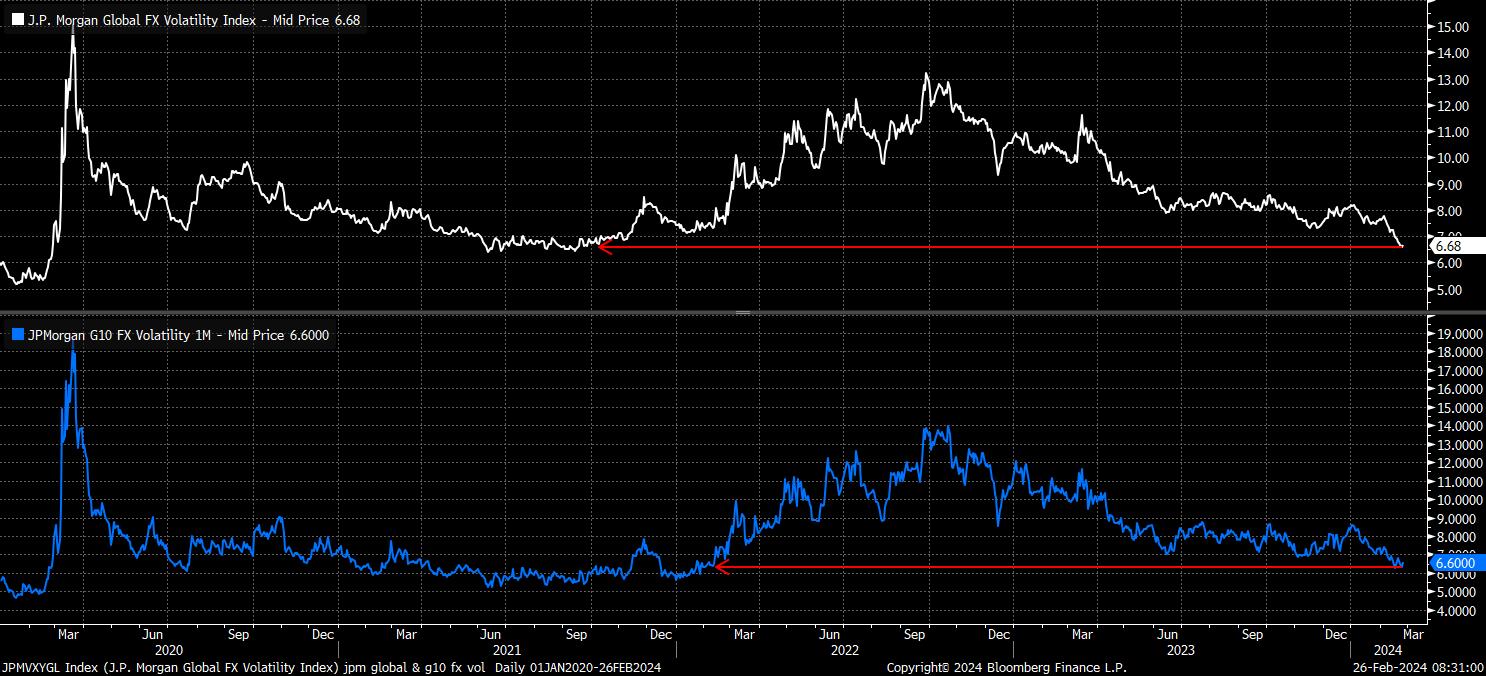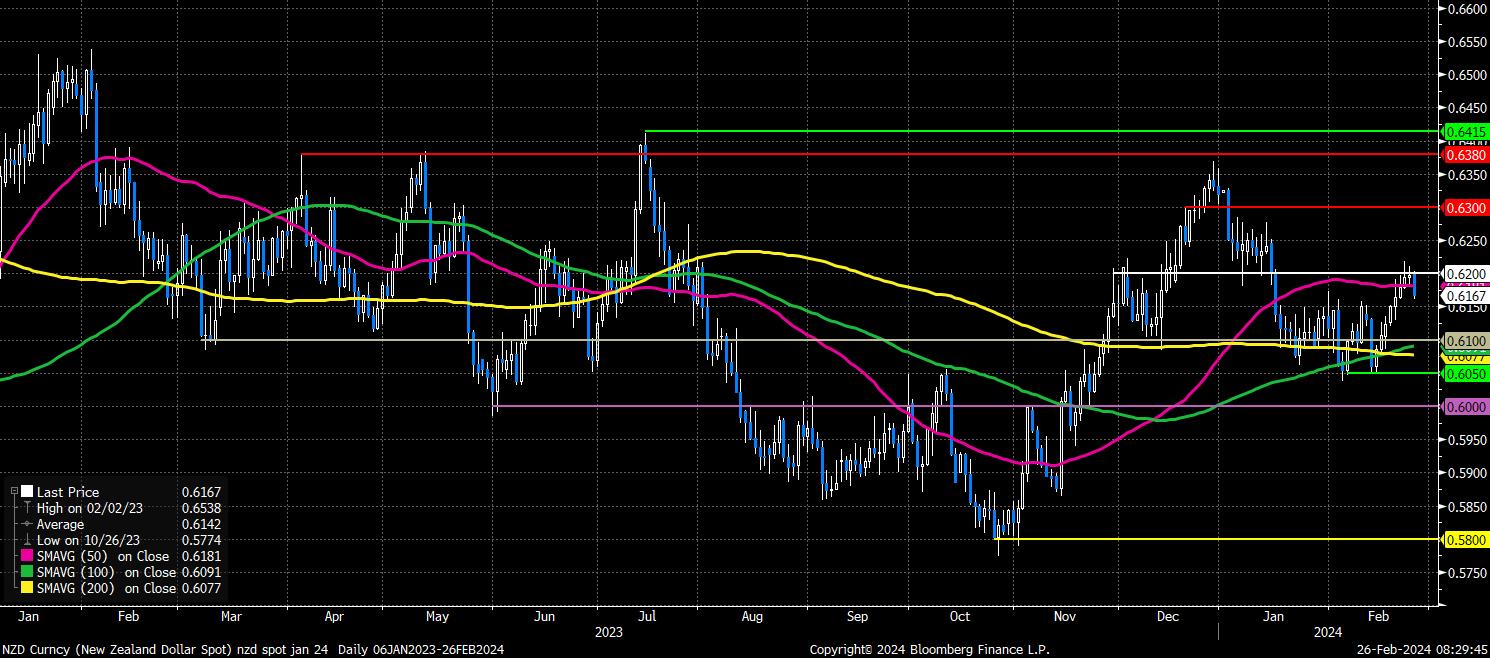Macro Trader: Factors That May Awaken The FX Market

The wonderful world of G10 FX has been my ‘bread and butter’ since day one in the City. It was therefore with much amusement that I read Warren Buffett’s annual shareholder letter at the weekend, in which the ‘Oracle of Omaha’ noted “Neither Greg [Abel] nor I believe we can forecast market prices of major currencies. We also don’t believe we can hire anyone with this ability”. In short, Mr Buffett is bang on the money.
Currency forecasting has never been a particularly easy business, over any time horizon. Yes, in the uber-long-term, factors such as valuation compared to NEER and REER, as well as trade and current account deficits can, and do, play a significant role. They are, though, of little use in the short- and medium-term where, given the relative nature of the FX market, participants are typically focused squarely on divergences – be that in yield, inflation, or growth – between economies, and thus the currency in question.
In any case, at the moment, currency forecasting seems more difficult than usual. Not because those divergences don’t exist – they do! – but because the divergences in question have all seemingly been well-discounted. This, then, results in the turgid, quiet, and frankly dull trading conditions that we’ve seen across the G10 board of late; tight ranges, lacklustre moves, and generally low levels of vol.
Naturally, this begs the question of what one should be watching in the weeks and months ahead as well as what, if anything, might shake the market out of its current slumber.
The NZD springs to mind at first to tackle the ‘weeks’ part of that question, with a live-ish RBNZ meeting on deck in the very early hours (UK time) of Wednesday morning. While a handful of local banks, and 2 of the 21 economists in the Bloomberg survey, expect a 25bp hike, the majority see the OCR remaining unchanged at 5.5%. NZD OIS sees around a 3-in-10 chance of a hike at the February meeting, while pricing around 15bp of further tightening this cycle – the only major central bank, ex-Japan, where further hikes are priced.
Personally, I see little reason for the RBNZ to tighten further, as disinflation continues, inflation expectations slip back towards the RBNZ’s target band, and as, worryingly, consumer spending shows signs of rolling over significantly. While the labour market remains tighter than policymakers would desire, and wage pressures intense, it would seem more prudent simply to retain the present level of restriction, rather than hike further, only to likely end up cutting more aggressively than would otherwise be required in Q3/4 24.
In any case, for the NZD, an RBNZ hike this week would likely see the Kiwi pop back towards the cycle highs around the 0.64 figure, while failure to live up to (relatively) hawkish expectations should see downside prevail, and the NZD give up a significant chunk of recent gains, in a decline back below the 50-day moving average.
Anyway, with the ‘weeks’ part of that earlier question now answered, we can turn to the ‘months’ part, given that a little potential vol in the NZD this week is unlikely to satisfy the desires of most for a more sustained pick up in FX vol.
Naturally, one turns once more to monetary policy to answer this question. Although the next move in rates for all G10 central banks, besides the BoJ, is almost certain to be a cut, likely marking the beginning of an easing cycle, there are set to be some notable divergences in the timing of such a cut, and the extent of policy normalisation that will subsequently be delivered. I use “normalisation”, incidentally, rather than ‘loosening’, as rates are likely to return to a more neutral level, with policy not likely to become outright ‘easy’ barring a financial accident.
In any case, while the broader direction of travel that policy will take should continue to prove supportive for the risk backdrop, and insulate global equities from significant shocks, the differing paths taken by G10 policymakers may, eventually, breathe some life into the FX arena.
In terms of who cuts first, the ECB and the SNB seem like the frontrunners at this stage – both dealing with more rapid than expected disinflationary progress, with the latter even now seeing CPI in the low-1%s, while the former continues to battle anaemic economic growth, and multiplying downside risks.
While an April ECB cut, as seems most likely at this point, and would pose a headwind for the common currency as markets increasingly move to price in such a reduction, cutting ‘slow and early’ might not be all bad news. There is an argument that such an early cut could in fact prove the foundations of a bull case for the EUR in H2 24, were said cuts able to put a floor under the bloc’s ailing economy though, the EUR will likely have to endure some short-term pain, before that potential long-term gain.
It’s not just the EUR that is of interest, though. The GBP is also worth some consideration, particularly with the SONIA curve not fully pricing the first 25bp BoE cut until the August MPC meeting.
A couple of week ago, I would’ve argued that this ‘higher for longer’ stance that the MPC are taking, coupled with the much more prolonged and painstaking dovish pivot that the Old Lady is making compared to peers, would support GBP upside, or at the very least put a floor under the quid in the short-term.
However, rhetoric emanating from the Bank has begun to shift, with Governor Bailey having noted that – in line with the view taken by the FOMC – inflation need not hit the 2% target before cuts are delivered, just that there must be “sustained progress” towards said price goal. This, then, removes what could’ve been a bullish GBP impetus, and arguably makes current market pricing appear a touch too hawkish, which should keep cable within a 1.26 – 1.28 range for the time being.
Everything, then, in the FX world, hinges on when the Fed kick off their own, and by extension the global rate cut cycle.
There seems little reason, in my mind, to be bearish on the greenback before this takes place, particularly as markets continue to hawkisly reprice the policy outlook, and with the Fed’s March ‘dot plot’ again likely to point to just 75bp of cuts this year, around 15bp more than markets currently price, which should continue to see Treasuries sell-off, naturally led by the front-end of the curve (in turn posing a headwind for the JPY, which remains a proxy rates trade).
It is now just the policy outlook that remains supportive for the greenback, however, with the ‘buy dollars, wear diamonds’ view having plenty of other building blocks underpinning it.
These include, the continued ‘goldilocks’ economic backdrop, comprised of immaculate, if bumpy, disinflation, with most measures well on their way back to 2% (particularly if one annualises MoM data), in addition to continued economic resilience, with the labour market remaining tight, and spending relatively resilient, all putting the US on course for a ‘soft landing’. Of course, this is not only an impressive backdrop in its own right, but particularly so when compared to the well-documented struggles being seen in other DMs.
As if that wasn’t enough reason to be bullish on the buck in the medium-term, one must also consider the other side of the ‘dollar smile’, with lingering haven demand as a result of simmering geopolitical risk in Ukraine, the Middle East, and elsewhere, also likely to provide support. November’s election, though probably not yet a tradeable theme, is also worth keeping on the radar, particularly with a Trump win, and subsequent tariff impositions, likely to be another bullish catalyst.
Lastly, one must consider the equity space, with major Wall Street indices continuing to print record highs on an almost daily basis, with the latest leg of the risk rally spurred on by last week’s blowout NVDA earnings print.
While said risk rally has spread elsewhere – Japan’s Nikkei 225, and the pan-European Stoxx 600 have also both printed fresh records – it is a move that continues to be driven, by and large, by chipmakers, and the broader tech sector. Hence, the US market should continue to outperform global peers, likely sparking significant further inflows as a result, and providing the final jigsaw piece to further support the bull case for the buck.
Related articles
Pepperstone không đại diện cho việc tài liệu được cung cấp ở đây là chính xác, hiện tại hoặc đầy đủ, và do đó không nên dựa vào nó. Thông tin, có phải từ bên thứ ba hay không, không được coi là một khuyến nghị; hoặc một đề nghị mua bán; hoặc một lời mời mua bán bất kỳ chứng khoán, sản phẩm tài chính hoặc công cụ nào; hoặc tham gia vào bất kỳ chiến lược giao dịch cụ thể nào. Nó không tính đến tình hình tài chính hoặc mục tiêu đầu tư của độc giả. Chúng tôi khuyên bất kỳ độc giả nào của nội dung này nên tìm kiếm lời khuyên của riêng mình. Mà không có sự chấp thuận của Pepperstone, việc sao chép hoặc phân phối lại thông tin này không được phép.


_eur_spot_2024-02-26_08-29-30.jpg)
_2024-02-26_08-29-15.jpg)
_YTD_st_2024-02-26_08-28-28.jpg)

